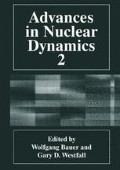Abstract
Multifragmentation (MF) is the break-up of colliding nuclei into many species of lighter nuclei, particularly intermediate mass fragments (IMF’s) with 3 ≤ Z IMF ≤ 30 [1]. MF occurs in many different kinds of nuclear reactions when the excitation energy per nucleon is comparable to the nucleon binding energy. At lower excitation energy, a compound nucleus is formed, which decays by evaporation of a few light particles (primarily neutrons, protons, and alphas), leaving a large residual nucleus that contains most of the original mass. At higher energy, the excited system decomposes entirely into light particles. As excitation energy increases, the final mass yields start at low excitation with a double structure peaked at the lowest and highest masses, progress through a power law mass distribution of IMF’s at intermediate excitation, and end at high excitation with an exponential distribution of only light particles. This evolution strongly resembles the progression of a heated fluid from the liquid state through the critical point into the gaseous phase. Since pioneering studies in the early 1980’s [2], intense experimental and theoretical effort has focused on this behavior, attempting to understand the mechanism of MF. Although it is not universally accepted, the idea of a nuclear liquid-gas phase transition has become the leading paradigm used to interpret MF phenomena. Many important questions remain unresolved, including:
-
does MF exhibited by different nuclear reactions have a common underlying physical mechanism?
-
do the excited systems equilibrate sufficiently to apply thermal concepts?
-
is the phase transition first order or continuous, and does this vary for different reactions?
-
what are the thermodynamic properties (e.g. temperature, density, entropy) of these systems?
-
what are the trajectories in the temperature-density plane for various reactions?
-
can the physical properties of nuclear matter, including the equation of state, be extracted from MF data?
Access this chapter
Tax calculation will be finalised at checkout
Purchases are for personal use only
Preview
Unable to display preview. Download preview PDF.
References
D. H. E. Gross, Rep. Progr. Phys. 53, 605 (1990).
A. S. Hirsch et al.,Phys. Rev. C29, 508 (1984).
H. E. Stanley, “Introduction to Phase Transitions and Critical Phenomena,” Oxford University Press, Oxford, 1971.
A. S. Hirsch et al.,in:,“Proceedings of the 12th Winter Workshop on Nuclear Dynamics,” (this volume), W. Bauer and G. Westfall, eds., Plenum Press, New York, NY, 1996.
N. T. Porile et al.,Phys. Rev. C39, 1914 (1989).
A. M. Poskanzer et al.,Phys. Rev. C3, 882 (1971).
K. Kwiatkowski et al.,Phys. Rev. Lett. 74 3756 (1995).
M. L. Gilkes et al., Phys. Rev. Lett. 73 1590 (1994).
J. B. Elliott et aL, submitted to Phys. Lett. B., 1996.
A. Hauger et al.,submitted to Phys. Rev. Lett., 1996.
G. Rai et al.,IEEE Trans. Nucl. Sci. 37 56 (1990).
W. Christie et al.,Nucl. Instr. Methods A255 46 (1987).
X. Campi, J. Phys. A19, L917 (1986); Phys. Lett., B208, 351 (1988).
R. W. Minich et al.,Phys. Lett. B118 458 (1982).
K. Summerer et al.,Phys. Rev. C42 1546 (1990).
Y. Yariv and Z. Fraenkel, Phys. Rev. C20, 2227 (1979).
D. Cussol et al., Nucl. Phys. A581, 298 (1993).
R. Wada et al.,Phys. Rev. C39 497 (1989).
K. Hagel et al.,Nucl. Phys. A486 429 (1988).
J. P. Bondorf et al., Phys. Rep. 257, 133 (1995).
R. K. Pathria, “Statistical Mechanics,” Pergamon Press, Oxford, 1972.
S. Albergo et aL, Nuovo Cimento A89, 1 (1985).
J. Pochodzalla et al.,Phys. Rev. Lett. 75 1040 (1995).
Author information
Authors and Affiliations
Editor information
Editors and Affiliations
Rights and permissions
Copyright information
© 1996 Springer Science+Business Media New York
About this chapter
Cite this chapter
Tincknell, M.L. et al. (1996). Excitation Energy and Temperature in the Multifragmentation of 1 GeV/Nucleon Au+C. In: Bauer, W., Westfall, G.D. (eds) Advances in Nuclear Dynamics 2. Springer, Boston, MA. https://doi.org/10.1007/978-1-4757-9086-3_37
Download citation
DOI: https://doi.org/10.1007/978-1-4757-9086-3_37
Publisher Name: Springer, Boston, MA
Print ISBN: 978-1-4757-9088-7
Online ISBN: 978-1-4757-9086-3
eBook Packages: Springer Book Archive

